
How To Clean Marble Floors – Professional Help
Last Updated on July 7, 2025 by David
Marble is a beautiful, elegant stone that brings a sense of luxury to any room. However, maintaining a marble floor, particularly a polished one, is not as straightforward as maintaining other types of flooring. If you need to learn how to clean your marble floors, look no further than this article.
How Is Marble Made?
Answering how to clean marble floors starts with understanding how it is made. Marble is a natural stone composed of limestone and other sedimentary minerals. Heat and pressure within the earth cause the individual mineral grains to recrystallise into a solid stone. Mineral impurities, such as clay, sand, and metal oxides, contribute to the creation of the various colours found in marble, including green, brown, and black. Geologists classify the stone as a non-foliated metamorphic rock.
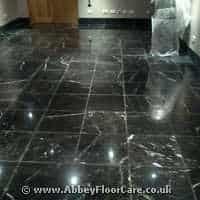
It is a versatile natural stone available in a variety of colours, patterns, and textures. Marble is a relatively soft stone compared to harder stones, such as granite. It is also quite a porous stone compared to Granite. Since ancient times, it has been used as a building and sculptural material, as well as a decorative feature on walls, floors, countertops, and furniture. It is a beautiful stone that adds value to any home.
How to Clean Marble Floors
Pro Tip: We recommend these products for daily cleaning of marble floors.
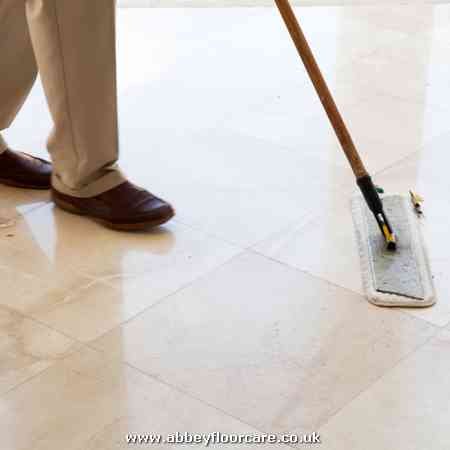
A Marble floor is one of the most beautiful natural stones. Marble floors have been used for millennia to create elegant and timeless flooring. It is just as popular today. Yet, Marble is a relatively soft stone, very porous, and can be easily damaged. Like all natural stone surfaces, marble requires regular cleaning to prevent soiling and staining. If you have a dirty, stained marble floor, here is a 7-step guide on how to clean it and restore the finish:
-
Use a dry mop or vacuum cleaner to remove dirt and dust.
-
Make up a cleaning solution with a marble cleaning chemical and water.
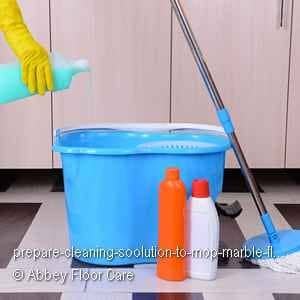
Use only a cleaner designed explicitly for marble. Lots of standard floor cleaners contain chemicals that can harm marble.
- Use a microfiber soft cloth, microfiber flat mop, sponge, or soft brush to give the floor a thorough clean, then rinse with clean water.
- Continue rinsing your soft cloth, sponge, or mop, and replace the cleaning solution when it becomes dirty. Also, replace the rinse water when it starts to become dirty.
- Allow the floor to dry. To speed up the drying process, use old towels to dry the floor.
- Treat any stains by following the guidelines below.
- Finally, apply an amenable-impregnating sealer to help protect the finish. Follow the manufacturer’s instructions and make sure that you don’t leave any sealer pooling on the surface.
Treating Stains on Marble Floors
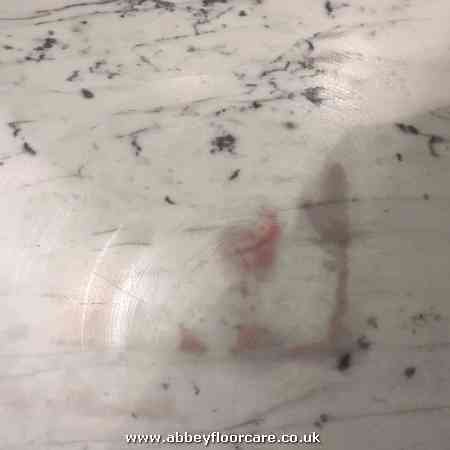
Spills must be removed immediately to prevent staining and damage. Absorb the spill into a paper towel, taking care not to spread the spill. Then, wash the area with a pH-neutral marble cleaner and dry it with a soft cloth. If you are unlucky and a stain remains, try the stain removal tips below.
How to Remove Stains from Marble
The longer a stain sits, the more difficult it will be to remove from marble floors. Stains must be treated immediately, as the longer they are allowed to set, the harder they will be to remove. Be aware that different types of stains require various treatments.
How to Remove Oil Stains from Marble Surfaces
Vegetable oils, milk, cosmetics and other oil-based spills will quickly penetrate the porous surface of your marble floors, leaving a persistent dark stain.
Removing the stain requires drawing the oil out of the marble. Start by mixing a few drops of strong alkaline cleaner or ammonia with your marble cleaner. Try to clean the stain with a few drops of strong alkaline cleaner added to your dilute marble cleaner. If this doesn’t work, try a poultice paste with acetone and leave it on for a couple of days. Rinse with a dilute marble cleaner and wipe dry.
How to Remove Organic Stains from Marble
Coffee, tea, wine, foods and other organic substances usually create a brown or pink stain. Mix a solution of 12% hydrogen peroxide and three drops of ammonia. A lower concentration of hydrogen peroxide will be less effective. Apply the hydrogen peroxide solution to the area to remove the stain. Use caution when applying this treatment to darker marble floors, as it may cause the stone to lighten.
Removing Soap Residues from Marble
Soap residues rapidly fill the pores in marble shower units, sinks, baths, and vanity units, staining the finish. So, all your marble surfaces that come into contact with natural soap should be cleaned regularly to remove the soap residue. Fortunately, this is a straightforward task. Use a marble deep-cleaning chemical to dissolve the soap, and then rinse with your marble cleaner. Alternatively, you can use a solution of ammonia and water, but this is not a pleasant job. Also, take care when using ammonia, as it can dull the marble’s surface.
How to Remove Rust Stains from Marble
Metal furnishings and containers can rust and stain the marble. Brass and bronze are often used as a decorative insert in marble floors. If they are left wet, they will make brown stains that are very difficult to remove.
If you are lucky, you may be able to top polish our austenitic stainless steel with 0000-grade wire wool. If the stain is persistent, you will need to use a poultice mixture with a rust removal treatment. Most of these treatments are acidic, allowing them to etch the surface of your marble floors. You may need professional help to remove the etch damage and repolish the area.
How to Remove Ink Stains from Marble
If you have ink stains from markers and pens, you can make a poultice with a small amount of acetone. Deep ink stains and paint will require the assistance of commercial paint removers, which can damage the marble. You may be better off seeking professional help.
How to Remove Etch Marks from Marble
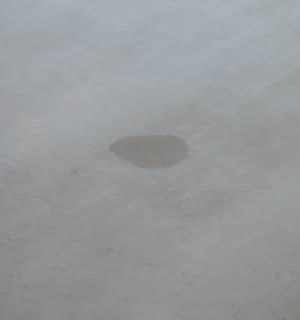
Etch damage is usually caused by acidic spills (fruit juices, vinegar, tomato-based sauces, etc.) or cleaning products containing harsh chemicals. Some spills cause etch marks without causing a stain, while others both etch and stain the surface. As an example, water stains and ring marks are engraved, not stains. Minerals in the water penetrate the surface and break down the marble’s surface.
You can often remove water rings by buffing the area with 0000 steel wool. Take care to remove any steel dust, as it will rust and stain the marble. If it gets wet
If you have a larger area of etching or the damage is deep, then you may need professional assistance to refinish and polish the damaged surface.
What Is A Marble Poultice
A marble poultice is used to draw stains out of marble floors. A liquid cleaner or chemical is mixed with a carrier to form a creamy paste.
How to Make a Marble Poultice
Poultice materials include fuller’s earth, diatomaceous earth, powdered chalk, talcum powder, baking soda, flour, etc. You can also use cotton wool or white kitchen paper to make a poultice.
To make a marble poultice, mix a poultice material with water, acetone, hydrogen peroxide, or other suitable liquids to form a thick paste. If you are using cotton wool or kitchen paper, soak it with the chemical, then let it drain so the chemical is not dripping.
How to Use a Marble Poultice
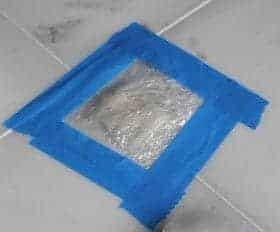
- Wet the area with a little of the cleaning chemical.
- Apply a 5 to 1mm thick layer of poultice over the stain.
- Use cling film or clear plastic to cover the poultice.
- Tape the edges of the cover with masking tape to prevent the chemical from evaporating.
- Leave the poultice for 24 to 48 hours. The liquid chemical will draw the stain into the absorbent material.
- When the paste is dry, remove the cover and wipe off the material with a damp cloth. Try not to scrape off the poultice, as you could scratch the marble.
- Rinse with your marble cleaner and buff dry with a soft microfiber cloth.
- Continue until the stain is completely gone or until the polisher has removed it.
If you can’t remove the stain with a poultice, you may need to call on professional help.
Additional Tips on Marble Stain Removal
Before using a poultice material, take care to consider the following:
- Test any poultice on an inconspicuous area of the marble to make sure it does not cause any damage.
- Do not mix ammonia and bleach, as this creates a highly toxic chlorine gas.
- Take care if using hydrogen peroxide on darker stones;
- Rinse any treatments well to remove all residues
- Try to dry the marble, lest standing water spots leave marks.
- If you are treating rust stains, the poultice etches the marble. Use 0000 wire wool to try to polish out the etch mark. Alternatively, consider hiring a professional.
- Try to prevent staining your marble in the first place.
- Reseal marble surfaces at least once per year.
- Use coasters under glasses and cups.
Recommended Cleaners for Marble Floors
You want your marble to always look clean and beautiful. Regular cleaning and planned maintenance are essential. Use caution when handling any cleaning chemicals. Avoid using acid cleaners (many washroom cleaners contain acids) and strong alkali cleaners, such as ammonia and bleach. These cleaners will etch and damage the surface of the marble, dulling the shine and making it easy for soil to penetrate the surface. For daily use, use a pH-neutral cleaner explicitly manufactured for cleaning marble and diluted according to the manufacturer’s instructions. If you clean your marble with the correct cleaner and keep the seal topped up, you should never need to use a stronger alkaline cleaner. More potent cleaning chemicals should only be used for interim maintenance tasks.
Is It Safe To Use Steam Cleaning On Marble Floors?
Heavy-duty commercial steam cleaners should not be used to clean marble floors in the home. The hot steam will cause thermal expansion in the marble, and over time, the surface can start to degrade. If the marble has fillers, the high heat can cause the fillers to fall out, leaving holes.
Home steamers are generally safe for cleaning marble floors because the steam temperature is not too high. However, you will probably find that a steam cleaner will not clean as well as a marble cleaner and a microfiber cloth or mop. Additionally, steam cleaners can overwet the mop head, which reduces its cleaning effectiveness.
If you care for your marble correctly, you won’t need a steam cleaner.
If you need help, contact us about how to clean Marble floors. Marble is the premier choice for marble flooring.
Grout Cleaning of Marble Floors

Stone marble floors enrich the appearance of any room. Whilst marble is porous, the grout can be even more permeable. Over time, soil and mopping slurries seep and soak into the grout, making it look and feel unappealing and ruining the appearance of your marble flooring. The grout can be cleaned using simple products like baking soda, but take care not to damage the marble while cleaning the grout.
- Fill a bowl with your recommended marble cleaner diluted with cold or warm water.
- Work in easy-to-reach areas
- Use a soft cloth or dust mop to remove any dry soil.
- Use a gentle scrubbing motion to clean the grout between the tiles with a grout-cleaning brush. Use a gentle scrubbing motion to help clean the grout.
- You can use baking soda to help agitate the grout but take extreme care when using it to avoid damaging the surrounding marble tiles.
- Rinse the grout with clean, warm water
- Dry the grout using a soft, absorbent cloth or towel.
Polishing Marble Floor

marble floor polishing work
Polished marble gives an incredible elegance to any room. However, the stone finish can deteriorate if it is not maintained correctly. Harsh chemicals and high traffic will damage the shine, making the marble dull and unattractive. Regular maintenance and polishing will preserve the finish, keeping the marble looking beautiful.
Before polishing, like any stone floor, the floor should be carefully cleaned and any stains and damage treated. If the finish is in good condition, dry polishing with high-quality diamond pads may be sufficient. If the floor has some wear, the surface may need to be honed and then polished with marble polishing powder. This is a specialist task, best carried out by professionals.
Maintenance
You can extend the life of your marble floor’s shine by following these simple guidelines.
Remove dry soil with a dust mop or vacuum.
Frequent cleaning is essential for maintaining the finish on a marble floor. Dry sweeping with a dust mop or vacuuming will remove abrasive dust and dirt. When using a vacuum cleaner on a marble floor, opt for soft tools. Metal floor tools can scratch marble and damage the finish.
Regular damp mopping
Use a soft microfiber dust mop with pH-neutral marble cleaning chemicals to mop the floor, helping to keep it in tip-top condition.
Clean up spills as soon as they occur to prevent staining and etching on your marble. After removing a spill, clean the area with your marble cleaner, rinse with clean tap water and dry the floor thoroughly.
Use walk-off mats at doorways and entrances.
Use walk-off mats by entrance doorways and in high-traffic areas to prevent dust and dirt from being tracked into the home. This will avoid scratching by footwear.
If you need help, contact us about how to clean Marble floors, an exquisite choice for homeowners.
Recent Posts:
We work throughout the country, just some of our work counties:
Copyright © Fabritec - Abbey Floor Care. Natural Stone Floor Restoration in Surrey and South West London FAQ - Privacy Policy - Terms And Conditions


